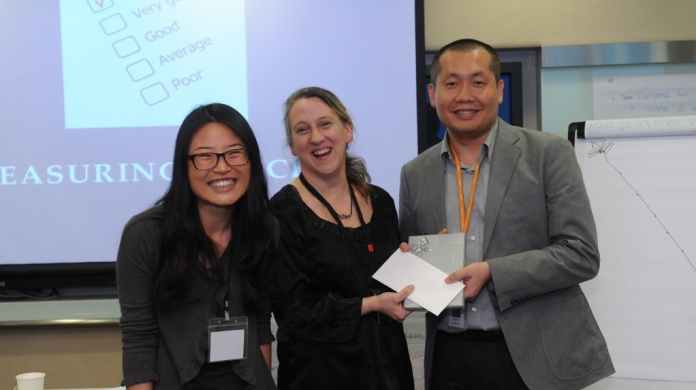I was asked to name a place in the world I would least like to go to. I picked Hong Kong – the tall buildings, the congestion, the sheer number of people, the speed of everything. I went there first in October 2012 to take me out of my comfort zone, and to my complete surprise I fell in love with it. The skyscraping buildings I thought I’d hate, I adored. The bustle of humanity had so much to teach me. The people and the politics bumping along side by side were intriguing and beguiling in equal measure.
When I came back I tried to describe my experiences, but it was hard: I never quite got the whole picture, every time I turned a corner or met someone new, my perspective changed. Rather than finding this threatening or alienating, I welcomed it. It has made me refresh my view of the UK, too.
I worried that I would struggle with understanding and being understood (I am hearing impaired) but this was not the case at all. People had a real desire to listen and to understand – the cultural sector seemed hungry to hear about equivalent experiences in the UK, not to hold them up to glorify, but to gently and respectfully interrogate them to find out what they could learn.
I work in the diversity sector in the UK, working alongside artists, companies and organisations with a belief that difference is delicious and not divergent. I feel diversity – in all manifestations – adds texture and vibrancy. I was invited back to Hong Kong in March 2013 to talk more about this approach, in the context of programming the work of disabled and other diverse artists, and the impacts it can have.
I was asked to work with the staff of West Kowloon Cultural District (WCKD), and also with the staff of Arts with the Disabled Association, Hong Kong (ADA HK) and the Centre for Community Cutural Development (CCCD) – the Hong Kong arts for the disabled organisation and community arts organisation, both of which have strong track records of working with disabled and diverse people, as participants, audiences and artists. It was an absolute privilege to bring these groups together within WKCD and seed conversations that have the potential to have an impact on change over the next ten years.
WKCD – and Hong Kong as a whole – is on the verge of something that we can only dream of in the UK. It has such an opportunity to place equality and inclusion at the heart of WKCD, and increasingly at the heart of its whole cultural infrastructure. This is not just in terms of access for audiences, but also in relation to programming and the way in which people can participate in all aspects of the arts. The rapid growth, and constant building and rebuilding, means that aspects we view as insurmountable obstacles in the UK can be virtually eradicated with a few years within Hong Kong. But it's not about the ‘hardware’ as they call the built infrastructure, inclusion is all about the ‘software’, the ways in which people think, feel and behave towards those they perceive as different.
Hong Kong is a melting pot – its history as always been as a place of convergence, of confluence. They ‘do’ diversity well in some respects. What if they can extend that principal of welcome, of acceptance, of learning from difference rather than challenging or trying to eradicate it, and ensure it’s placed deep in the ethos of everything they deliver as part of their cultural offer? I don’t perceive Hong Kong – or anywhere – as a place free of inequality and discrimination. Some groups, many groups, still have to fight for their right to be heard, to be seen, but I find the potential for shift dazzling there and am delighted to be even a tiny, tiny part of it.
There was a piece commissioned by Unlimited last year, by artist Sue Austin, in which she created an installation of herself in her wheelchair, underwater. She's swooping and zooming through coral and shoals of fish, wearing a summer dress and sunglasses and just looking so free. I want every single person on the planet to see this footage, as I fundamentally believe it alters how people think about disability, and wheelchairs in particular. So often people see disability through the lens of limitation – it’s all about what we can’t do, rather than what we can. This just turns everything on its head. The wheelchair is repositioned as a symbol of freedom and liberation – which it is. I love it! I was lucky enough to make a short film linked to Sue Austin (and a number of other disabled artists last year), which people can see on The Space, the Arts Council England and BBC online arts portal. Go there and check out PUSH ME to see Sue and others.
If I could bring one idea to the UK from another country, it would be the Japanese concept of 'wabi-sabi', defined by Wikipedia as “beauty that is imperfect, impermanent and incomplete”. I’ve never been to Japan – I came across this approach of glorying in the imperfect and it seemed very aligned to my way of viewing the world, helping people to see things from a different perspective and not get caught up in ‘traditional’ ways of seeing or experiencing the world. My adventures in Hong Kong began with me following a feeling that I should get out of my comfort zone – maybe I should get over to Japan quick, before Hong Kong becomes too comfortable for me!
